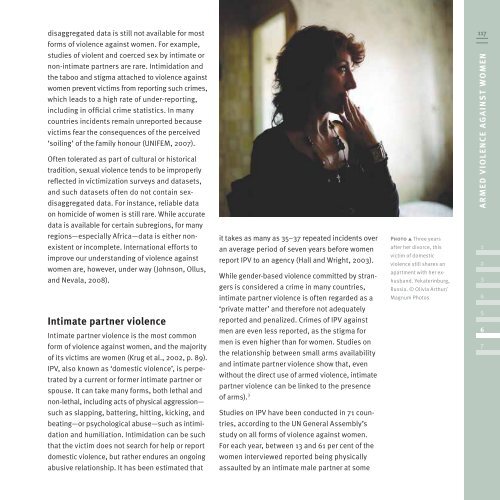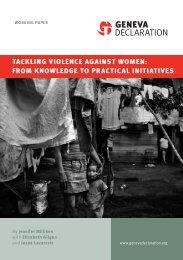Global Burden of Armed Violence - The Geneva Declaration on ...
Global Burden of Armed Violence - The Geneva Declaration on ...
Global Burden of Armed Violence - The Geneva Declaration on ...
Create successful ePaper yourself
Turn your PDF publications into a flip-book with our unique Google optimized e-Paper software.
disaggregated data is still not available for most<br />
forms <str<strong>on</strong>g>of</str<strong>on</strong>g> violence against women. For example,<br />
studies <str<strong>on</strong>g>of</str<strong>on</strong>g> violent and coerced sex by intimate or<br />
n<strong>on</strong>-intimate partners are rare. Intimidati<strong>on</strong> and<br />
the taboo and stigma attached to violence against<br />
women prevent victims from reporting such crimes,<br />
which leads to a high rate <str<strong>on</strong>g>of</str<strong>on</strong>g> under-reporting,<br />
including in <str<strong>on</strong>g>of</str<strong>on</strong>g>ficial crime statistics. In many<br />
countries incidents remain unreported because<br />
victims fear the c<strong>on</strong>sequences <str<strong>on</strong>g>of</str<strong>on</strong>g> the perceived<br />
‘soiling’ <str<strong>on</strong>g>of</str<strong>on</strong>g> the family h<strong>on</strong>our (UNIFEM, 2007).<br />
Often tolerated as part <str<strong>on</strong>g>of</str<strong>on</strong>g> cultural or historical<br />
traditi<strong>on</strong>, sexual violence tends to be improperly<br />
reflected in victimizati<strong>on</strong> surveys and datasets,<br />
and such datasets <str<strong>on</strong>g>of</str<strong>on</strong>g>ten do not c<strong>on</strong>tain sex-<br />
disaggregated data. For instance, reliable data<br />
<strong>on</strong> homicide <str<strong>on</strong>g>of</str<strong>on</strong>g> women is still rare. While accurate<br />
data is available for certain subregi<strong>on</strong>s, for many<br />
regi<strong>on</strong>s—especially Africa—data is either n<strong>on</strong>-<br />
existent or incomplete. Internati<strong>on</strong>al efforts to<br />
improve our understanding <str<strong>on</strong>g>of</str<strong>on</strong>g> violence against<br />
women are, however, under way (Johns<strong>on</strong>, Ollus,<br />
and Nevala, 2008).<br />
Intimate partner violence<br />
Intimate partner violence is the most comm<strong>on</strong><br />
form <str<strong>on</strong>g>of</str<strong>on</strong>g> violence against women, and the majority<br />
<str<strong>on</strong>g>of</str<strong>on</strong>g> its victims are women (Krug et al., 2002, p. 89).<br />
IPV, also known as ‘domestic violence’, is perpe-<br />
trated by a current or former intimate partner or<br />
spouse. It can take many forms, both lethal and<br />
n<strong>on</strong>-lethal, including acts <str<strong>on</strong>g>of</str<strong>on</strong>g> physical aggressi<strong>on</strong>—<br />
such as slapping, battering, hitting, kicking, and<br />
beating—or psychological abuse—such as intimi-<br />
dati<strong>on</strong> and humiliati<strong>on</strong>. Intimidati<strong>on</strong> can be such<br />
that the victim does not search for help or report<br />
domestic violence, but rather endures an <strong>on</strong>going<br />
abusive relati<strong>on</strong>ship. It has been estimated that<br />
it takes as many as 35–37 repeated incidents over<br />
an average period <str<strong>on</strong>g>of</str<strong>on</strong>g> seven years before women<br />
report IPV to an agency (Hall and Wright, 2003).<br />
While gender-based violence committed by stran-<br />
gers is c<strong>on</strong>sidered a crime in many countries,<br />
intimate partner violence is <str<strong>on</strong>g>of</str<strong>on</strong>g>ten regarded as a<br />
‘private matter’ and therefore not adequately<br />
reported and penalized. Crimes <str<strong>on</strong>g>of</str<strong>on</strong>g> IPV against<br />
men are even less reported, as the stigma for<br />
men is even higher than for women. Studies <strong>on</strong><br />
the relati<strong>on</strong>ship between small arms availability<br />
and intimate partner violence show that, even<br />
without the direct use <str<strong>on</strong>g>of</str<strong>on</strong>g> armed violence, intimate<br />
partner violence can be linked to the presence<br />
<str<strong>on</strong>g>of</str<strong>on</strong>g> arms). 3<br />
Studies <strong>on</strong> IPV have been c<strong>on</strong>ducted in 71 coun-<br />
tries, according to the UN General Assembly’s<br />
study <strong>on</strong> all forms <str<strong>on</strong>g>of</str<strong>on</strong>g> violence against women.<br />
For each year, between 13 and 61 per cent <str<strong>on</strong>g>of</str<strong>on</strong>g> the<br />
women interviewed reported being physically<br />
assaulted by an intimate male partner at some<br />
Photo ! Three years<br />
after her divorce, this<br />
victim <str<strong>on</strong>g>of</str<strong>on</strong>g> domestic<br />
violence still shares an<br />
apartment with her ex-<br />
husband. Yekaterinburg,<br />
Russia. © Olivia Arthur/<br />
Magnum Photos<br />
117<br />
A R M E D V I O L E N C E AG A I N S T WOMEN<br />
1<br />
2<br />
3<br />
4<br />
5<br />
6<br />
7









